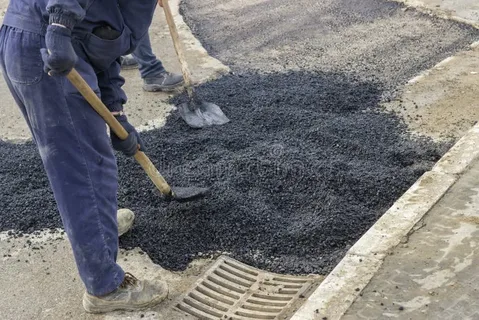Asphalt surfaces endure constant exposure to heavy traffic, weather elements, and natural wear and tear over time. Cracks, potholes, and surface deterioration can not only compromise the appearance of your pavement but also lead to safety hazards and costly repairs if left unattended. Asphalt patching is an essential maintenance practice that helps restore the integrity of your pavement, extending its lifespan and improving its functionality. Whether you’re dealing with minor surface damage or significant structural issues, seamless asphalt patching ensures a smooth and durable surface that can withstand the test of time.
Understanding Asphalt Patching
Asphalt patching is a repair method used to fix localized damage in asphalt pavement. This process involves removing deteriorated asphalt and replacing it with new material to restore the structural integrity of the surface. Patching is essential for maintaining roads, driveways, parking lots, and other paved areas, preventing further deterioration and ensuring a safe and functional surface.
There are several methods of asphalt patching, including:
1. Throw-and-Roll Patching
This is a temporary patching method used for quick repairs. It involves placing hot or cold mix asphalt into a pothole and compacting it with a roller or vehicle tires. While this method is cost-effective and fast, it is not a long-term solution and may require frequent reapplications.
2. Semi-Permanent Patching
This method involves cleaning the damaged area, applying tack coat for adhesion, and placing new asphalt before compacting it. It provides a more durable solution compared to the throw-and-roll method.
3. Full-Depth Patching
For deeper or more severe damage, full-depth patching is the best approach. This involves cutting out the damaged section, replacing the base material if necessary, and filling it with fresh asphalt. This technique ensures maximum durability and prevents further deterioration.
4. Infrared Asphalt Patching
Infrared asphalt patching is an advanced method that uses infrared technology to heat the existing asphalt, allowing it to blend seamlessly with new material. This results in a durable, smooth, and long-lasting repair that prevents water penetration and future damage.
Benefits of Seamless Asphalt Patching
1. Extends Pavement Lifespan
Cracks and potholes allow water to seep beneath the pavement, leading to further deterioration. Timely asphalt patching prevents this damage, significantly extending the lifespan of your pavement.
2. Enhances Safety
Damaged asphalt poses safety risks to pedestrians and drivers. Patching eliminates trip hazards, uneven surfaces, and potholes, ensuring a smooth and secure pavement.
3. Improves Aesthetic Appeal
Cracked and deteriorated asphalt can make a property look neglected. Seamless patching restores the pavement’s appearance, enhancing curb appeal and creating a positive impression.
4. Cost-Effective Maintenance
Addressing minor issues early with asphalt patching helps prevent costly full-scale replacements. Regular maintenance is a budget-friendly approach to preserving pavement integrity.
5. Enhances Drainage
Poorly maintained asphalt can result in water pooling, which accelerates deterioration. Proper patching restores the surface’s evenness, allowing for effective drainage and preventing water damage.
The Asphalt Patching Process
Step 1: Inspection and Assessment
Before patching, a thorough inspection is conducted to assess the extent of the damage. Identifying the cause of deterioration helps determine the best repair method.
Step 2: Preparation
The damaged area is cleaned of debris, loose asphalt, and vegetation. In some cases, a saw is used to create clean edges for better patch adhesion.
Step 3: Application of New Asphalt
Depending on the patching method, hot mix asphalt or an infrared process is used to fill the damaged area. The asphalt is spread evenly and compacted using a roller to ensure a seamless bond.
Step 4: Compaction
Proper compaction is crucial for durability. The patched area is compressed to remove air voids and achieve a smooth, even surface.
Step 5: Sealing and Finishing
A sealant may be applied to the patched section to enhance durability and protect against moisture infiltration. The surrounding edges are blended to create a seamless finish.
Common Causes of Asphalt Damage
Understanding the factors that contribute to asphalt deterioration can help in preventing future damage. Some common causes include:
- Water Damage: Moisture seeps into cracks, weakening the pavement structure.
- Heavy Traffic Load: High traffic areas experience faster wear and tear.
- UV Exposure: Sunlight causes oxidation, leading to brittleness and cracking.
- Poor Installation: Subpar materials or improper installation result in premature deterioration.
- Freeze-Thaw Cycles: Water expands when frozen, exacerbating cracks and potholes.
- Oil and Chemical Spills: Petroleum-based substances degrade asphalt, weakening its structural integrity.
Preventive Maintenance Tips
To reduce the need for frequent asphalt patching, consider these preventive measures:
- Sealcoating: Apply a protective layer to shield asphalt from UV rays and water penetration.
- Regular Inspections: Monitor pavement for cracks and signs of wear, addressing them early.
- Prompt Repairs: Fix minor cracks before they expand into larger issues.
- Proper Drainage: Ensure adequate drainage to prevent water pooling.
- Routine Cleaning: Remove debris, oil, and other contaminants that can weaken asphalt.
Choosing a Professional Asphalt Patching Service
For long-lasting results, hiring a professional asphalt contractor is recommended. A skilled team will:
- Use high-quality materials for durable repairs.
- Employ advanced patching techniques for a seamless finish.
- Provide expert assessment and tailored solutions.
- Ensure proper compaction and finishing for extended pavement life.
Conclusion
Seamless asphalt patching is a crucial investment in maintaining the safety, functionality, and appearance of your pavement. By addressing cracks, potholes, and surface deterioration early, property owners can prevent costly repairs and enhance the longevity of their asphalt surfaces. Whether it’s a minor patch job or a full-depth repair, choosing the right method and working with experienced professionals ensures a durable and aesthetically pleasing result. Regular maintenance and proactive care further protect your pavement, keeping it in optimal condition for years to come.

